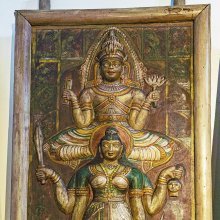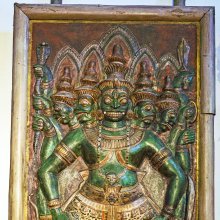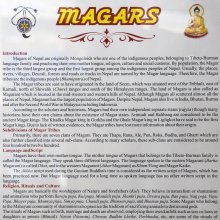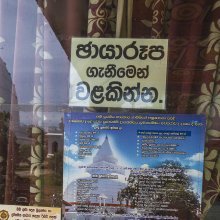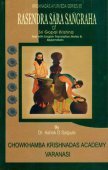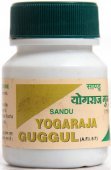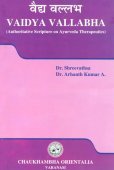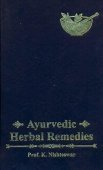Roka, Rōkā: 13 definitions
Introduction:
Roka means something in Hinduism, Sanskrit, the history of ancient India, Hindi, biology, Tamil. If you want to know the exact meaning, history, etymology or English translation of this term then check out the descriptions on this page. Add your comment or reference to a book if you want to contribute to this summary article.
Alternative spellings of this word include Rok.
Images (photo gallery)
India history and geography
Source: Cologne Digital Sanskrit Dictionaries: Indian Epigraphical GlossaryRoka.—(Chamba), cash. See rūka under rū. Note: roka is defined in the “Indian epigraphical glossary” as it can be found on ancient inscriptions commonly written in Sanskrit, Prakrit or Dravidian languages.

The history of India traces the identification of countries, villages, towns and other regions of India, as well as mythology, zoology, royal dynasties, rulers, tribes, local festivities and traditions and regional languages. Ancient India enjoyed religious freedom and encourages the path of Dharma, a concept common to Buddhism, Hinduism, and Jainism.
Biology (plants and animals)
Source: Google Books: CRC World Dictionary (Regional names)1) Roka in Ethiopia is the name of a plant defined with Tamarindus indica in various botanical sources. This page contains potential references in Ayurveda, modern medicine, and other folk traditions or local practices It has the synonym Tamarindus erythraeus Mattei (among others).
2) Roka is also identified with Trichilia emetica It has the synonym Elcaja roka Forssk. (etc.).
Example references for further research on medicinal uses or toxicity (see latin names for full list):
· De Fructibus et Seminibus Plantarum (1791)
· Acta Botanica Austro Sinica (1989)
· Prodromus Stirpium in Horto ad Chapel Allerton vigentium (1796)
· Flora Aegyptiaco-Arabica (1775)
· Journal of Ethnopharmacology (1984)
· Journal of Ethnopharmacology (1985)
If you are looking for specific details regarding Roka, for example extract dosage, health benefits, pregnancy safety, chemical composition, diet and recipes, side effects, have a look at these references.

This sections includes definitions from the five kingdoms of living things: Animals, Plants, Fungi, Protists and Monera. It will include both the official binomial nomenclature (scientific names usually in Latin) as well as regional spellings and variants.
Languages of India and abroad
Sanskrit dictionary
Source: DDSA: The practical Sanskrit-English dictionaryRoka (रोक).—1 A hole.
2) A boat, ship.
3) Moving, shaking.
-kaḥ 1 Brightness.
2) Buying with ready money, cash transaction.
Derivable forms: rokam (रोकम्).
Source: Cologne Digital Sanskrit Dictionaries: Shabda-Sagara Sanskrit-English DictionaryRoka (रोक).—n.
(-kaṃ) 1. A hole, a chasm, a vacuity. 2. A boat. 3. Moving, shaking. m.
(-kaḥ) 1. Buying with ready money. 2. Light. E. ruc to shine, aff. ghañ; or ru-kan tasya-nettvam .
Source: Cologne Digital Sanskrit Dictionaries: Benfey Sanskrit-English DictionaryRoka (रोक).—i. e. ruc + a, I. m. 1. Light. 2. Buying with ready money. Ii. n. 1. A hole. 2. A boat. 3. Moving.
Source: Cologne Digital Sanskrit Dictionaries: Cappeller Sanskrit-English DictionaryRoka (रोक).—1. [masculine] brightness, light.
--- OR ---
Roka (रोक).—2. [masculine] rokas [neuter] phenomenon of light.
Source: Cologne Digital Sanskrit Dictionaries: Monier-Williams Sanskrit-English Dictionary1) Roka (रोक):—1. roka m. (√1. ruc) light, lustre, brightness, [Ṛg-veda iii, 6, 7]
2) = kraya-bhid, [cf. Lexicographers, esp. such as amarasiṃha, halāyudha, hemacandra, etc.] (buying with ready money, [Horace H. Wilson])
3) n. (only [cf. Lexicographers, esp. such as amarasiṃha, halāyudha, hemacandra, etc.]) a hole, vacuity
4) a boat, ship
5) = cara or cala
6) = kṛpaṇa-bheda.
7) 2. roka m. light, splendour, [Ṛg-veda vi, 66, 6.]
Source: Cologne Digital Sanskrit Dictionaries: Yates Sanskrit-English DictionaryRoka (रोक):—(kaṃ) 1. n. A hole; a boat; a shaking. m. Ready money; light.
[Sanskrit to German]
Sanskrit, also spelled संस्कृतम् (saṃskṛtam), is an ancient language of India commonly seen as the grandmother of the Indo-European language family (even English!). Closely allied with Prakrit and Pali, Sanskrit is more exhaustive in both grammar and terms and has the most extensive collection of literature in the world, greatly surpassing its sister-languages Greek and Latin.
Hindi dictionary
Source: DDSA: A practical Hindi-English dictionaryRoka (रोक) [Also spelled rok]:—(nf) a ban, restriction, check; prevention; stay, scotch, hedge; hindrance; barrier; -[ṭoka] restriction, obstruction; opposition; —[thāma] prevention; check, temporary remedy; —[lagānā] to impose a ban/restriction.
...
Kannada-English dictionary
Source: Alar: Kannada-English corpusRoka (ರೊಕ):—[noun] = ರೊಕ್ಕ [rokka].
--- OR ---
Rōka (ರೋಕ):—[noun] a deep hollow in the surface of a body; a hole.
--- OR ---
Rōka (ರೋಕ):—[noun] = ರೊಕ್ಕ [rokka].
Kannada is a Dravidian language (as opposed to the Indo-European language family) mainly spoken in the southwestern region of India.
Tamil dictionary
Source: DDSA: University of Madras: Tamil LexiconRōkā (ரோகா) noun < Urdu ruqqā.
1. Bit, piece; துண்டு. [thundu.]
2. Chit, note; சீட்டு. [sittu.]
Tamil is an ancient language of India from the Dravidian family spoken by roughly 250 million people mainly in southern India and Sri Lanka.
See also (Relevant definitions)
Starts with (+11): Rokab el-gamal, Rokacamani, Rokacanti, Rokada, Rokadabahi, Rokadabamki, Rokadi, Rokadi Hundi, Rokadi-hundi, Rokadiya, Rokadoba, Rokaha, Rokainu, Rokala, Rokam, Rokana, Rokanem, Rokani, Rokanitanam, Rokanivaranam.
Ends with (+9): Anaroka, Anumroka, Aroka, Atiroka, Baroka, Hiroka, Jharoka, Mararyvoroka, Mboroka, Miangaroka, Moroka, Mroka, Nasaviroka, Pundroka, Puroka, Ratnamaliyapundroka, Rokaroka, Sashroka, Seroka, Spiroka.
Full-text (+444): Roga, Atiroga, Saroga, Rogaharin, Cakshuroga, Kshudraroga, Paparoga, Rogagrasta, Rogabhu, Rogaraja, Shiroroga, Rokas, Rogashanti, Taimira, Kshayaroga, Rogin, Hridroga, Rogashantaka, Tamra, Arogata.
Relevant text
Search found 48 books and stories containing Roka, Raogaa, Roga, Rogaa, Rōka, Rōkā; (plurals include: Rokas, Raogaas, Rogas, Rogaas, Rōkas, Rōkās). You can also click to the full overview containing English textual excerpts. Below are direct links for the most relevant articles:
Jivanandana of Anandaraya Makhin (Study) (by G. D. Jayalakshmi)
Analysis of Śvāsa (Śvāsaroga) < [Chapter 6 - Dramatic aspects of the Jīvanandana Nāṭaka]
Medicines administered for different diseases < [Chapter 4 - Āyurvedic principles in Jīvanandana Nāṭaka]
Fifteen Diseases (Mentioned In Act II) < [Chapter 4 - Āyurvedic principles in Jīvanandana Nāṭaka]
Rasa Jala Nidhi, vol 4: Iatrochemistry (by Bhudeb Mookerjee)
Part 25 - Treatment of Udara-roga (22): Application of parpati < [Chapter VI - Diseases affecting the belly (udara-roga)]
Part 1 - Characteristics of Udara-roga (diseases affecting the belly) < [Chapter VI - Diseases affecting the belly (udara-roga)]
Part 15 - Treatment for enlargement of spleen and liver (14): Ganadhipa rasa < [Chapter VII - Enlargement of spleen (plihodara) and liver (yakridudara)]
Rig Veda (translation and commentary) (by H. H. Wilson)
The Garuda Purana (by Manmatha Nath Dutt)
Chapter CLXXXII - The Nidanam of Shlipadam (Elephantiasis) < [Dhanvantari Samhita]
Chapter CLXXII - The Nidanam of diseases of the head < [Dhanvantari Samhita]
Chapter CLXXV - The Nidanam, of diseases peculiar to parturient women < [Dhanvantari Samhita]
Atharvaveda and Charaka Samhita (by Laxmi Maji)
Rasendrasāra Saṅgraha (Āyurveda book) < [Chapter 1 - Introduction]
Grahaṇī (sprue-syndrome) according to Caraka < [Chapter 4 - Diseases and Remedial measures (described in Caraka-saṃhitā)]
Treatments of Śvāsa-roga (respiratory problems) < [Chapter 3 - Diseases and Remedial measures (described in Atharvaveda)]
Sushruta Samhita, Volume 6: Uttara-tantra (by Kaviraj Kunja Lal Bhishagratna)
Chapter XLIV - Symptoms and Treatment of Jaundice (Pandu-roga) < [Canto III - Kaya-chikitsa-tantra (internal medicine)]
Chapter XXV - Symptoms of diseases of the head < [Canto I - Shalakya-tantra (ears, eyes, nose, mouth and throat)]
Chapter LIV - Symptoms and Treatment of Worms (Krimi-roga) < [Canto III - Kaya-chikitsa-tantra (internal medicine)]
Related products
(+5 more products available)
